1.4 Additional Precautions and Personal Protective Equipment (PPE)
Certain pathogens and communicable diseases are easily transmitted and require additional precautions to interrupt the spread of suspected or identified agents to health care providers, other patients, and visitors (PIDAC, 2012). Additional precautions are used in addition to routine precautions and are defined by how a microorganism is transmitted (Perry et al., 2014).
Types of Additional Precautions
There are three categories of additional precautions: contact precautions, droplet precautions, and airborne precautions.
Contact precautions are are the most common type of additional precautions. They are used in addition to routine practice for patients who are known or suspected to be infected with microorganisms that can be transferred by direct (touching) or indirect (shared equipment) contact. Types of organisms in this category are antibiotic-resistant organisms (AROs) such as methicillin-resistant Staphylococcus aureus (MRSA), vancomycin-resistant Enterococci (VRE), extended spectrum beta-lactamase (ESBL), Clostridium difficile (CDI), carbapenemase-producing organisms (CPO), diarrhea, and scabies. AROs are also known as multi-drug-resistant organisms (MDROs).
Droplet precautions are used in addition to routine practices for patients who are known or suspected to be infected with microorganisms that are spread through the air by large droplets. Types of organisms and unconfirmed conditions in this category include mumps, influenza, vomiting of unknown cause, norovirus, and unconfirmed cough.
Airborne precautions are used in addition to routine practices for patients who are known to have or are suspected of having an illness that is transmitted by small droplet nuclei that may stay suspended in the air and be inhaled by others. These particles can remain infectious for a long period of time when spread through the air. Types of organisms in this category include tuberculosis (TB), measles, chicken pox (varicella), disseminated zoster, and severe acute respiratory syndrome (SARS).
Special considerations:
- Signage and accommodation: Signs must state the type of precaution required for the patient and be displayed on the door or at the foot of the bed. Accommodation in a private room, or cohorting patients with the same type of infection, is acceptable. Private bathrooms are preferred.
- Personal protective equipment (PPE): PPE is clothing or equipment worn to protect staff from catching or transmitting an infection. Depending on the type of additional precaution, PPEs are required when performing patient care tasks and may consist of a mask, gown, gloves, face shield, and/or eyewear.
- Consistent communication: Patients on additional precautions must be clearly identified on their patient chart or requisitions to ensure all hospital personnel, departments, or other health care settings know what additional precautions to use.
- Visitor information: Visitors must be informed of the precautions and must wear the appropriate PPEs and follow the routine practices for health care settings. Visitors also must wear the same PPEs as the health care provider if providing direct care for the patient.
- Multiple additional precautions: Some microorganisms may be transmitted by more than one mode and, therefore, more than one additional precaution is needed. For example, a patient with suspected or confirmed Ebola virus disease (EVD) would be on contact and droplet precautions.
- Aerosol procedures: Aerosol-generating medical procedures (such as tracheostomy care, CPR, nebulized therapy) may increase risk of transmitting infectious agents. Airborne precautions may be initiated during specific procedures when a patient is suspected of having or confirmed to have TB.
Tables 1.1, 1.2, and 1.3. summarize the three categories of additional precautions.
| Table 1.1 Contact Precaution Guidelines | ||||
|---|---|---|---|---|
| PPE | Private Room | Visitors | Patient Transport | Cleaning |
| Gown, gloves | Private room preferred or cohort patients.
Must have own dedicated equipment. |
Gown and gloves must be worn if providing direct care.
Must perform hand hygiene before and after care. Must not go into other patient rooms. |
Patient: none required
Staff: gown and gloves |
Additional daily room cleaning may be required.
|
| Data source: PIDAC, 2012; PHAC, 2013; Siegal, Rhinehart, Jackson, & HICPAC, 2007 | ||||
| Table 1.2 Droplet Precautions | ||||
|---|---|---|---|---|
| PPE | Private Room | Visitors | Patient Transport | Cleaning |
| Gloves, gown, and a surgical mask if within two metres of the patient | Private room preferred or cohort.
Must have own dedicated equipment.
|
Gown, gloves, surgical masks, and eye protection are worn for all activities within two metres of the patient.
The patient must wear a surgical mask when leaving the room. The door may remain open. Strict adherence to hand hygiene must be observed. Gloves, gown, and surgical mask must be worn if providing direct care. Must perform hand hygiene before and after care. Visitors may not go into other patient rooms. |
Patient: gown, surgical mask | Additional daily room cleaning may be required. |
| Data source: PIDAC, 2012; PHAC, 2013; Siegal et al., 2007 | ||||
| Table 1.3 Airborne Precautions | ||||
|---|---|---|---|---|
| PPE | Private Room | Visitors | Patient Transport | Cleaning |
| Must wear N95 respirator prior to entering room.
Strict adherence to hand hygiene. Must remove N95 respirator after exiting the room. No immune-compromised persons to enter room. Care providers should have current vaccines. |
Yes.
Must have a negative pressure room. Must have own dedicated equipment. Keep the door closed whether or not the patient is in the room. The room should have bathroom facilities. The room must be a single room, preferably one that is under negative pressure. When a negative pressure room is unavailable, refer to your health authority policy to determine whether a transfer to another facility is mandated. |
Gloves, gown, and surgical mask required if providing direct care.Must perform hand hygiene before and after care.
Must not go into other patient rooms. |
Patient: must wear surgical mask
Staff: N95 mask |
Additional daily room cleaning may be required. |
| Data source: PIDAC, 2012; PHAC, 2013; Siegal et al., 2007 | ||||
Personal Protective Equipment (PPE)
Additional precautions require the use of personal protective equipment (PPE), which is equipment or clothing worn by staff to prevent the transmission of infection from patient to staff or to family member (PIDAC, 2012). All PPE must be applied and removed in a specific order to ensure the skin, nose, mouth, and eyes are covered to prevent transmission of infection to health care providers. Depending on the type of additional precaution or risk assessment, a gown, goggles, face shield, and mask (surgical or N95) may be used during patient care. Refer to Checklist 6 for steps to take when donning (putting on) PPE.
Checklist 6: Donning PPEDisclaimer: Always review and follow your hospital policy regarding this specific skill. |
|||
Safety considerations:
|
|||
| Steps | Additional Information | ||
|---|---|---|---|
| 1. Remove rings, bracelets, and watches. Perform hand hygiene. | This prepares hands for direct patient care.
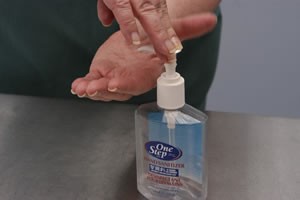 |
||
| 2. Apply waterproof long-sleeved gown. Tie the neck and waist strings. | Waterproof gown prevents any potential cross-contamination from blood or body fluids onto forearms and body.
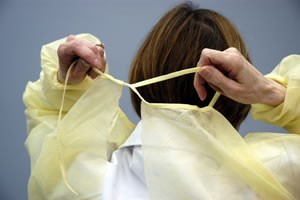 |
||
| 3. Apply surgical or N95 mask. Ensure the fit is secure with no air leaks. Secure the metal band around the nose and pull mask over chin as required. | Wearing a poor-fitting mask is the number one reason for exposure to pathogens for health care providers.
Masks should be worn if provider is within two metres of a coughing or sneezing patient or if there is a potential for spray of secretions or excretions. 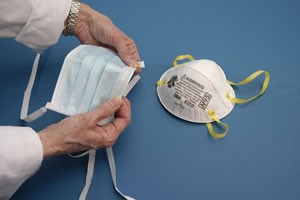 Replace mask if it becomes wet or soiled. 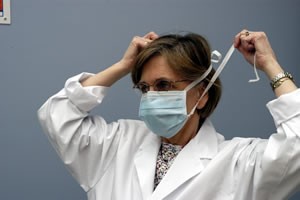 |
||
| 4. Apply goggles or face shield. | Goggles or a face shield prevents accidental exposure to eyes, nose, and mouth. Goggles can be placed on top of eyeglasses.
Prescription glasses are not an alternative to goggles as they do not protect the entire eye. 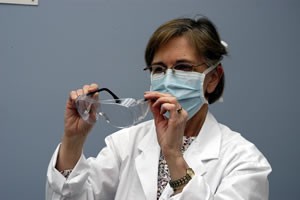 |
||
| 5. Apply non-sterile gloves over top of the cuff of the gown. | Non-sterile gloves ensure complete coverage of skin on arms for direct patient care.
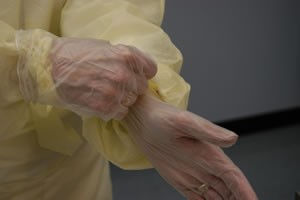 |
||
| Data source: Barratt, Shaban, & Moyle, 2011; PIDAC, 2012; PHAC, 2012b | |||
See Checklist 7 for steps on how to doff or remove PPE.
Checklist 7: Doffing PPEDisclaimer: Always review and follow your hospital policy regarding this specific skill. |
|||
| Steps | Additional Information | ||
|---|---|---|---|
| 1. Remove gloves. | Grasp outer edge of glove by wrist and peel away from hand, rolling the glove inside out. Roll it into a ball in gloved hand.
With the bare hand, reach under the second glove and gently peel down off the fingers. 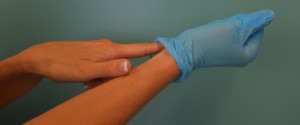 Drop glove into garbage bin. Always perform hand hygiene after removing gloves. Gloves are not tear- or leak-proof. Hands may have been contaminated upon removal of the gloves. |
||
| 2. Perform hand hygiene. | Clean hands if they feel or look dirty.
 |
||
| 3. Remove gown. | Remove gown in a manner that does not contaminate clothing. Starting at the neck ties, pull the outer (contaminated) part forward and, turned inward, roll into a ball. Discard in appropriate receptacle bin.
 |
||
| 4. Perform hand hygiene. | Always perform hand hygiene after removing gown. Hands may have been contaminated upon removal of the gown.
 |
||
| 5. Remove eye protection or face shield. | Arms of goggles and the headband on the face shield are considered clean. Handle these only by the sides. The front of the face shield or goggles is considered contaminated. Dispose them according to agency policy.
 |
||
| 6. Remove mask/N95 respirator. | Ties, earlobe loops, or straps are considered clean and may be touched. If tied, remove bottom tie first, then top tie. Remove ear loops or straps by leaning forward to allow the mask to slip off your face.
Dispose of the mask in the garbage bin.  |
||
| 7. Perform hand hygiene. | This step reduces the transmission of microorganisms.
 |
||
| Data source: Barratt et al., 2011; Perry et al., 2014; PHAC, 2012b; Siegal et al., 2007 | |||
Blood or Body Fluid (BBF) Exposure
A blood and body fluid (BBF) exposure is defined as an exposure to potentially infectious body fluids or blood through the following methods: a puncture wound by a sharp object or needle (percutaneous exposure), from a body fluid/blood splash onto your mucous membranes (permucosal exposure) or exposure through eczema, an open wound/skin or scratch (non-intact skin exposure) (BCCDC, 2015).
Post-exposure management is only required when (1) percutaneous, permucosal, or non-intact skin is exposed to a BBF; (2) the exposure is to blood or potentially infectious body tissue or fluid; (3) the source is considered potentially infectious (e.g., patient is part of a high-risk group, exposure occurred in a high-risk setting, or patient has a positive test); and (4) the exposed person is considered susceptible to HIV, hepatitis B, or hepatitis C. Checklist 8 explains what to do if exposed.
Checklist 8: BBF ExposureDisclaimer: Always review and follow your hospital policy regarding this specific skill. |
|||
Safety considerations:
|
|||
| Steps | Additional Information | ||
|---|---|---|---|
|
1. Wash the exposed skin, mucous membrane, or eye. |
Skin: Wash the area thoroughly with soap and water.
Mucous membranes or eye: Rinse area with water or normal saline. Allow injury/wound site to bleed freely and then cover lightly. Do not promote bleeding of percutaneous injuries by cutting, scratching, or squeezing or puncturing the skin. This may damage the skin and increase uptake of any pathogens. Do not apply bleach or soak wound/injury in bleach. |
||
|
2. Contact first aid for assistance and obtain proper forms. These forms are also available in emergency departments. |
If unable to contact first aid, proceed to the emergency room. |
||
|
3. Advise your supervisor or charge nurse of the incident. Ask them to complete the required form and return it to you. |
This step allows for follow-up by the manager, in relation to a BBF exposure. | ||
|
4. A risk assessment should be completed within two hours. Go to the emergency room or urgent care centre and be assessed by a physician/NP. Inform the department personnel that an occupational BBF exposure has occurred. You will be assessed and blood work will be drawn. |
Emergency rooms or other health agencies are supplied with antiretroviral kits from the BC Centre for Excellence in HIV/AIDS.
Physicians will assess your risk of exposure and the risk of transmission from source. |
||
|
5. Following treatment, return to your department and report the incident according to agency policy. |
This ensures that the proper procedure is followed and the incident form is filled out to prevent or minimize further exposure. | ||
|
Data source: BCCDC, 2015 |
|||
Critical Thinking Exercises
- A family member has come into the health care setting to visit his mother, who has been admitted with chicken pox. List four infection preventive measures to discuss with the family member.
- How is PPE selected for patient care?

